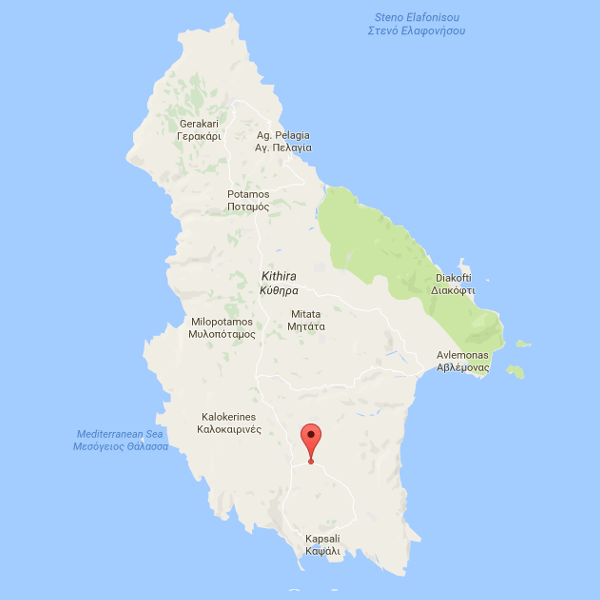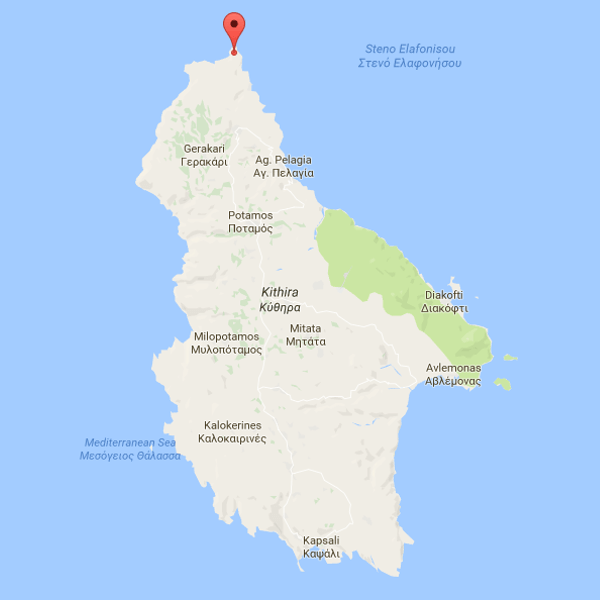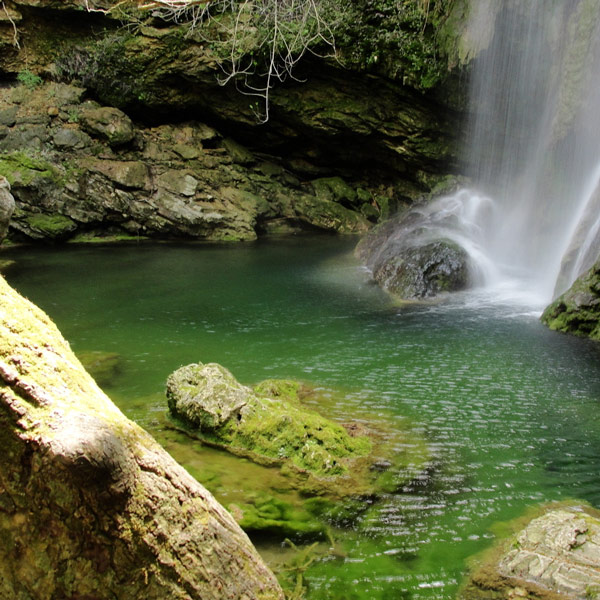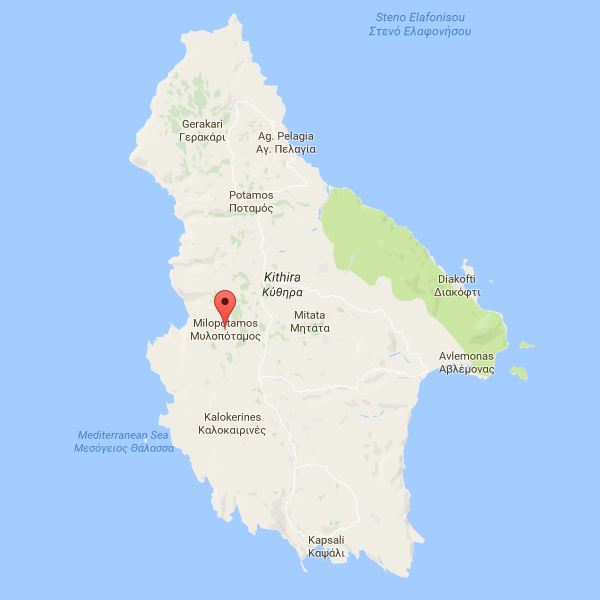Sights
Discover the sights of Kythira
Monastery of Myrtidiotissa
In the western part of Kythira, through the village of Kalokerines and sheltered between the pine trees, lies the Monastery of the Virgin Myrtidiotissa (“of the Myrtle Tree”), who is considered the patroness of Kythira. A visit to the miraculous icon of the Virgin, and to learn of it’s history, is an experience that no visitor should miss out on.
Katouni Bridge
Behind the central town of Livadi lies the impressive stone bridge of Katouni. Commissioned during the British occupation by Colonel Macfell, this is the first and largest stone bridge in Greece still functional today. Resting on 13 arches, the bridge measures 110m in total length, with a height of 15m and width of 6m. Construction started in 1821 and was completed in 1826 by forced labour.
Rumour has it that the bridge was built for the sake of Macfell’s mistress; while the colonel lived in Katouni, she lived in the opposite village of Livadi. In order for the two to meet more easily, the English Colonel ordered a bridge to be built across the dividing valley.
Chytra
Opposite Kapsali bay, just 3 miles away, is the islet “Chytra”, which is also called “Egg” by the locals. It has an area of about 40 acres, while the large and steep height combined with the huge cave with the thousands of colors of its seabed make it a visit that you should not miss!!!
Chytra is easily accessible with the Glass Bottom boat and Captain Spyros who organizes daily excursions for only ~15€ per person. You can reserve your seat by calling captain Spyros at: +306974022079
Fortress of Chora (Castro)
In the south of the island, overlooking Chora and the bay of Kapsali, lies the Venetian fortress of Chora (or Castro), the namesake of today’s capital which was established in 1503. From here you have a splendid view across the south of the island, Crete and Antikythira. The cannons date back to 1660, marking the fortification as a modern settlement that was inhabited by noble families and refugees. The fortress of Chora also houses the Kytherian Historical Archiveon.
Cave of Agia Sofia in Mylopotamos
A visit to this unique cave is bound to leave a lasting impression on any visitor. First mapped by the famous Petrocheilos couple (Kytherian Spelaeologists), the cave radiates a sense of enchantment, not only through its impressive stalactites and stalagmites, but also with the many stories that surround it. The cave has a total depth of 2,200m, however the route that is open for visitors only spans a length of 275m. The cave starts at 60m above sea level and finishes at 30m under ground. It is the largest of three caves on Kythira with the same name, and legend has it that they are all connected. Upon entering the cave you pass a small church built in 1875, which holds a service every September 17th, in celebration of Saint Sophia.
Visiting hours: Please contact the Municipality of Kythira on +30 27360 31213
Paleochora
In the North eastern part of the island, just east of Potamos, lies the old capital of Kythira. This fortified settlement harboured a large part of the Kytherian population for over 3 centuries and was destroyed and looted by the pirate Barbarossa in the mid-15th century.
Paleochora was the island’s first capital. The small town, initially called Agios Dimitrios, is believed to have been built by Monemvasians in the late 11th or 12th century. The area had the geographical advantage that it was not visible from the sea and had a plentiful freshwater supply from springs in the nearby valley. The first settlement was probably built around the year 1000 with protective stone walls, parts of which are still preserved today. According to the legend, the fortress contained 70 churches, an exhorbitant number in relation to the total area of Paleochora. The fortified city was destroyed by the fleets of Haiderin Barbarossa who, under the command of the Turkish sultan, took the state by storm in 1537. Victims of the ensuing massacre are estimated around 7000.
Lighthouse of Moudari
Built by the British in 1857, on the northern coast of Kythira on Cape Spathi, the lighthouse of Moudari is one of the largest in Greece. The path to the lighthouse passes through a beautiful landscape and is an ideal destination for walkers.


Byzantine Musuem
After years of continued efforts, the First Department of Byzantine Antiquities presents the collection of Byzantine and late-Byzantine art, hosted in the late-Byzantine Church of Ascension in Kato Livadi. Here you can see Byzantine frescoes and small portable works of iconography on display, such as images and objects of ritual.
Visiting hours: please contact the museum on +30 27360 31731.
Archaeological Museum
The original Archaeological Museum in Chora was demolished in 2006 after it suffered heavy damage from a powerful earthquake. Since 2014, a new museum has opened in it’s place and is definitely worth visiting. The museum’s collection includes tombstones, coins, vases, statues such as Aphrodite and Eros and the famous Archaic period statue, the Lion of Kythira.
Visiting hours: Please contact the museum on +30 27360 31739
Kytherian Folklore Collection
The Kytherian Folklore Collection documents the personal efforts of the now retired teacher Dimitri Lourandos, who has collected traditional objects from Kytherian everyday life over many years with the help of his students. Today the collection is hosted in the old Town Hall, next to the police station in Chora.
Visiting hours: Please contact Mr Lourantos on +30 27360 31336
Water Mills
For many visitors, the enchanting settlement of Mylopotamos is a small slice of paradise. The name ‘Mylopotamos’ literally translates to ‘Water Mills’, and the village houses old traditional water mills that were used in the past for grinding wheat. These mills are still standing to this day and there is a small walking path along the riverbed which leads past them.
Waterfall of Fonissa
Further along the path that leads past the Water Mills of Mylopotamos you will find the secluded waterfall of Fonissa, which falls from an overhanging ledge around 20m high. The cascading waters form a clear, cold pool at its base, where in hot summer months some brave few swimmers test the icy temperatures. According to local legend, a little girl drowned here long ago, giving the waterfall its name (meaning “murderess”). Besides its beautiful scenery, this green water hole offers cool shelter during the summer heat waves.




















